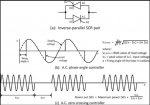With SCR heating controls, there are two basic TYPES of control used, and how you read the output will depend on which type. The two are Phase Angle Control and Zero Cross Proportional Time control (the 3rd method is to just use them as a solid state contactor, but that is not any different than any contactor).

In Phase Angle control, each SCR is pulsed to allow only a portion of EACH sine wave through and since you will have the other SCR on the other half of the sine wave, each phase will see an RMS voltage and current flow that can still be thought of as a sine wave. But it does mean that your meter must be able to read and display RMS values from that discontinuous flow. In old analog d'arsonval iron vane meters, this was inherent in the design but with digital meters it had to be done as an algorithm. That algorithm is collectively referred to in the meter industry as "True RMS" because it takes into account the non-linearity of the way current is actually flowing in the circuit. So if you have a good quality DMM with True RMS, you will read the output of a Phase Angle Controlled SCR controller as an AC signal, both for current and for voltage.
In Zero Cross Proportional Time control, each phase is controlled by each set of SCRs being fully on, but the number of cycles they are on for is varied by the desired EFFECT on the heater element in terms of POWER (watts), regardless of what the voltage / current waveforms look like. So for example if you want 50%
watt output, you have the phases on for 30 cycles and then off for 30 cycles. If you want 25% output, you have them on for 10 and off for 40, etc. etc. When you go to measure V or I on that output with a DMM, you will see AC, but it will jump from fully on to fully off and depending on the speed of the meter and sampling rate, the values you see will be all over the place. Most common meters do not have the necessary capability to integrate the values correctly. Again though, an analog meter will be better for that because the effect this has on the magnetics in the meter is similar to what is happening in the resistive heater elements.

